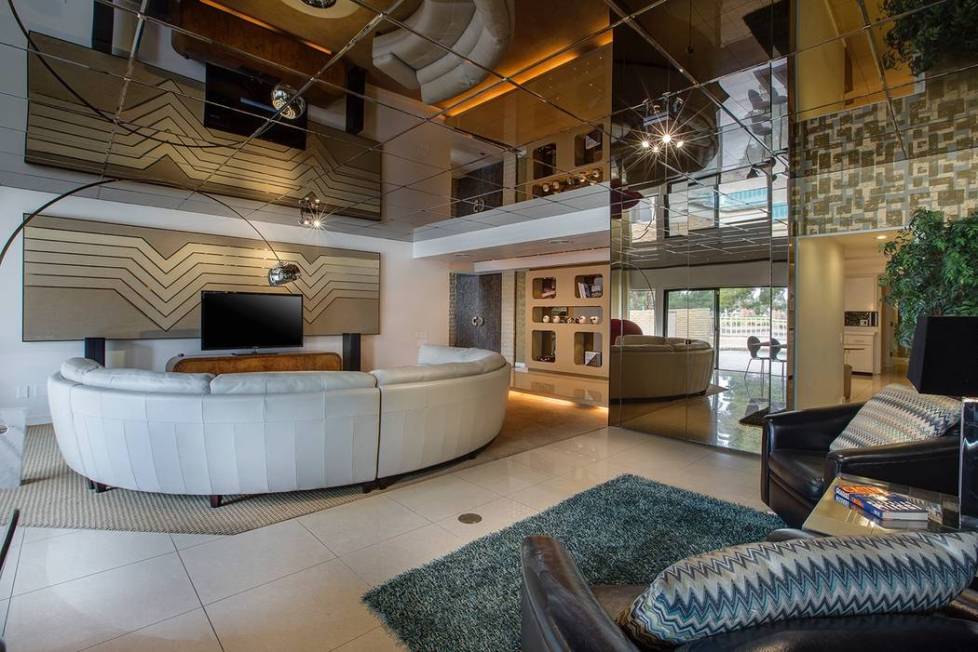‘Lefty’ Rosenthal’s former Las Vegas home back on market — PHOTOS

Steve Messer said the five owners of the former Las Vegas Country Club home of gangster Frank “Lefty” Rosenthal, who was depicted by Robert De Niro in the film “Casino,” are part of a club.
Messer, who bought the house 18 months ago, said he and the other owners have tried to preserve the home Rosenthal built in 1974 and sold in 1983 when he moved from Las Vegas after surviving an assassination attempt in a car.
Much of the home is as originally built with bulletproof doors and windows that Rosenthal included to protect his life from a mob hit. He died of a heart attack in Florida in 2008.
“It’s a very one-of-a-kind property and something you don’t see in Las Vegas. It’s built like a fortress and little Fort Knox,” said Messer’s Realtor Brian Burns. “There’s a scene in the movie where De Niro is coming down the stairs and someone is trying to shoot him from across the golf course. That bullet mark is still in the glass in the house.”
The ceilings have mirrors believed to have come from the former Stardust. Rosenthal’s liquor cabinet is there as is textured art commissioned by him that remains on the walls. Old casino chips and room keys are memorabilia in the home. Messer even got into the spirit of the home by having furniture that showcases a 1970s décor.
Messer, a 38-year-old regional director responsible for four states with Bacardi, is selling the home ahead of a transfer within the company. He said he bought the home in the guard-gated community when he moved to Las Vegas from Atlanta because of its heritage and history and proximity to the Strip.
“Whoever gets this home is going to enjoy it,” Messer said. “It’s like a club and whoever passes it on keeps the history. It’s not out of style. It’s still be a beautiful house and doesn’t need to be modernized.”
The home is listed by Synergy/Sotheby’s International Realty for $699,000, fully furnished. Messer bought the home for $665,000 from relatives of a man in the film industry. Since he bought it, Messer has renovated the kitchen with new Mongolian marble countertops and replaced carpeting with hardwood flooring.
The Martin Scorsese film wasn’t shot at Rosenthal’s property at the insistence of the homeowner’s association but was filmed instead at a home on Las Vegas National Golf Club, according to Burns. The film depicts Rosenthal managing casino properties as a front man for the Chicago mob.
Rosenthal bought the home at 972 Vegas Valley Drive in 1972, but Burns said it burned down and was replaced by him in 1974. It was claimed to cost $500,000, but many of the materials were “probably borrowed,” he said.
The two-story home has three bedrooms and 2½ baths. It measures 3,266 square feet and has a rectangular pool with a diving board. It’s located along the 15th fairway.
“It is built like a casino,” Burns said. “It’s commercial-grade construction with steel framing and commercial grade electrical conduit. He used one of the front bedrooms upstairs as his office, and he had a whole wall that was nothing but monitors for cameras in the casinos. He would watch what was going on inside the casinos from his house. In the 1970s, that was pretty high-tech back then.”
Rosenthal was considered a recluse who spent a lot of time at home where he was regularly visited by his friend, Tony Spilotro, who was depicted by Joe Pesci in the film, Burns said.
The home’s backyard has a view of the Stratosphere. Rosenthal selected the lot because he could sit in his upstairs office and view anyone coming down Vegas Valley Drive and Augusta Drive, Burns said.
The home has the original travertine tile flooring that extends from the front door entry to just inside the home, Burns said. The freestanding floating stairs also remain. The vaulted ceiling above the dining room is the original wood with gold leaf accents. The living room has the original sunken bar and cabinets and drawers. There’s even a hidden gun department.
The original closets are in place as is some of the wallpaper. There has been some upgrades with painting and wallpaper over the years and one of the baths was upgraded. Another has the original tub.
Although there’s no proof, there’s believed to be a secret escape tunnel leading out of the house, Burns said. In 2009, when a neighboring home burned down, construction workers found a tunnel leading from it to Rosenthal’s home, he said.
Burns applauds the decision by the five owners after Rosenthal to preserve its historic value, but it does have modern features with smart home system where you can control the temperature, lighting and security system remotely from home or from a tablet.
“Monetarily, there’s no such thing as historic value but aesthetically there is,” Burns said. “An appraiser isn’t going to give any extra value to piece of property because of its history but mentally people in their mind will add extra value to it because of its history.”